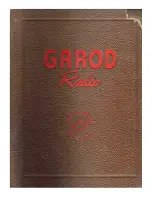
PAMS
Technical Documentation
NSC/W–1/3
Disassembly & Troubleshooting Instructions
Page 34
Original 11/99
Synthesizers
There are four oscillators generating the needed frequencies for RF–sec-
tion. They are
19.44 MHz reference oscillator,
1GHz UHF VCO frequency range
985.23 ... 1010.2 MHz
2Ghz UHF VCO frequency range
2046.2 ... 2107.2 Mhz
VHF VCO has two fixed frequencies,
322.38 Mhz for lowband
392.46 for upper band
VHF VCO operating frequency is controlled by the BAND–signal and the
PLL–circuit of the PLUSSA. All locals are locked to a stable reference oscil-
lator.
A practical way to check the synthesizer status is measuring the control volt-
age of the VCO from the Integrator capacitor. If the voltage is stable and
reasonable, the local oscillators are running correctly.
19.44 MHz reference oscillator
The 19.44 MHz oscillator frequency (G850)is controlled by the COBBA_D.
This signal is fed to the PLUSSA and TDMA1900 PLL circuit. All synthesiz-
ers use the divided signal as reference signal for the phase locked loop to
provide a correct LO frequency. The VCTCXO output signal is also used to
generate the 2LO frequency by multipliers.
The baseband clock signals are generated from this signal. The VCTCXO
output signal is buffered and connected to MAD2.
58.32 MHz 3–multiplier
The 3–multiplier is a discrete circuit which is used to generate the second
local frequency for the receiver. The multiplier output signal is connected to
the PLUSSA IN_X2 pin. In the PLUSSA the signal is multiplied by 2 and then
fed to the 2nd mixer.











































